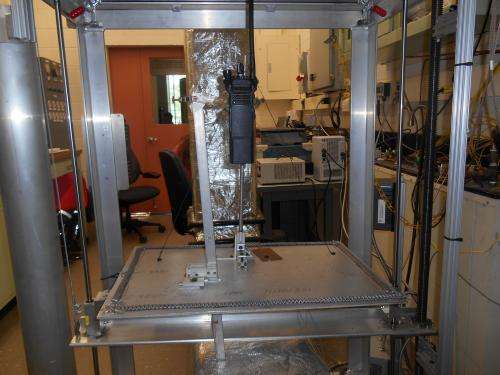Firefighters' portable radios may fail at elevated temperatures

New test results from the National Institute of Standards and Technology (NIST) confirm that portable radios used by firefighters can fail to operate properly within 15 minutes when exposed to temperatures that may be encountered during firefighting activities.
Firefighters rely on the radios to report their location and to communicate with other first responders as well as the incident command post or communications center. Performance problems with portable radios have been identified by the National Institute for Occupational Safety and Health as contributing factors in some firefighter fatalities.
All seven of the firefighter portable radios tested by NIST failed to perform properly within 15 minutes when exposed to temperature levels encountered in "fully involved" fires, as when all the contents in a room or structure are burning. Four of the handheld radios stopped transmitting, and three experienced significant "signal drift," rendering the radios unreliable for communication.
The failures occurred while the radios were subjected to a temperature of 160 degrees Celsius (320 degrees Fahrenheit), termed Thermal Class II conditions. The temperature is representative of a fully involved fire or conditions outside a room when its contents burst into flames simultaneously, a phenomenon known as flashover.
During the post-test cool-down period, three of the radios did not recover normal function.
Funded by the U.S. Department of Homeland Security, the NIST tests further ongoing work to develop performance standards for firefighter portable radio equipment, which includes radios, wearable combinations of speakers and microphones, and related items. The existing standard provides only general guidance—that portable radios "be manufactured for the environment in which they are to be used."
NIST researchers are furnishing their test data and performance measurements to the National Fire Protection Association, which is developing a performance standard for portable radios used by emergency personnel.
As important, the NIST team designed a prototype apparatus to electronically control testing equipment intended to consistently create thermal conditions representative of typical fire environments.
All radios tested by NIST performed reliably when exposed to a temperature of 100 degrees Celsius (212 degrees Fahrenheit) for 25 minutes, or Thermal Class I conditions, akin to a small fire in a room or fighting a fire from a distance.
No tests were conducted under more extreme fire conditions (Thermal Classes III and IV).
"Realistic and reliable performance tests provide clear design targets for portable radio manufacturers," explains NIST fire protection engineer Michelle Donnelly. "Standards incorporating these tests provide firefighters with the assurance that their equipment will perform as expected under specified thermal conditions."
More information: M.K. Donnelly, W.F. Young, and D. Camell, "Performance of Portable Radios Exposed to Elevated Temperatures" (NIST Technical Note 1850); September 2014
See NIST Technical Note 1474 at fire.nist.gov/bfrlpubs/fire06/PDF/f06001.pdf
Provided by National Institute of Standards and Technology




















